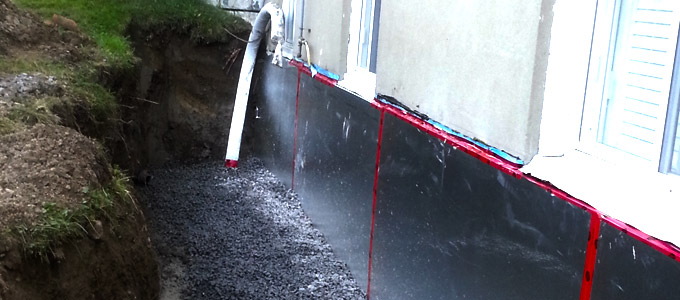When you buy a new or pre-owned home in Toronto there aren’t that many options for foundation waterproofing. Typically, waterproofing is done during the construction phase and you have to be ok with what was put in originally, or spend a few thousand dollars on excavating your home. So making a decision on the kind of waterproofing you want during the construction of your new home is a big one. Concrete usually isn’t waterproof. It might keep outflowing water but it can’t keep out water vapor, which can still cause severe damage inside. Finding a product that can keep water draining away from the concrete, as well as preventing it from moving through the concrete, is going to be key to keeping your home dry.
Waterproof Membranes
Waterproof membranes are the most successful way to prevent water from entering your home via foundation walls. They can be made of various different materials, and are basically applied to the outside walls of the foundation. Membranes suitable to use for foundation waterproofing need to meet three areas of criteria:
- Span a crack in a foundation
- Withstand water under hydro-static pressure
- Stop water vapor from entering a basement
The Benefits?
- Low cost for installation and materials
- Proven to work
- Environmentally friendly
- Stops water leaks in basements
Other Waterproofing Materials
A range of other types of materials is often used for foundation waterproofing in Toronto. These include:
Rubberized Asphalt
The most commonly used material for waterproofing a basement, is typically made from polyethylene or polyvinyl chloride (PVC) on the outer side to make it easier to handle. The side that sticks to the foundation walls is made of adhesive. In addition, there is a sprayable asphalt that also works well and is often seen in the GTA. These are both sensitive to ultraviolet light through, so they need to be covered for protection against sunlight.
Solvent-Based Asphaltic Emulsion
This delicately-named substance can either be applied by spray or by hand towels, but usually, it’s heated to use as a spray. It is then mixed with glass fibers to add protective resistance against cracking and shrinking. As cool as it sounds, it’s actually rarely used today in basement waterproofing.
Rubber
This is a sprayed-on material made from synthetic polymer mixed with a solvent. In addition to being sensitive to UV radiation, it can be installed as soon as 3 days after the foundation walls have been set, in temperatures as low as 17ºF.
Polyethylene
When creating a sheet membrane for waterproofing, polyethylene is used. This membrane is applied to the outside of the foundation and with three layers, it’s a pretty decent waterproofing method.
Bentonite
This is a mined clay product that becomes a thick gel and expands when it gets wet. The expansion helps prevent water from getting in, however, it does not limit the movement of water vapor. This clay typically gets squeezed between two layers of cloth or a geotextile. This is a highly popular material used for commercial foundation waterproofing in North America.
The fact is that there are many different products on the market today that can be used for waterproofing your foundation. Deciding which one to choose for your home during construction can be a difficult decision. Talk to your plumber, talk to your building contractor and even talk to your neighbors. Find out what springs are like in the area, whether they experience flooding during heavy rains, and ask what kind of basement waterproofing methods they use. The products and methods you decide to go with also depend on what you plan to use your basement or crawl space for. What’s important is that you find a method that’s right for you and your home.

